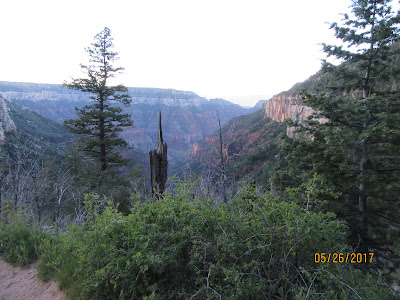We knew today was going to be a rough day, so we started again in the dark at 4 a.m. Our goal was to make it to the start of the uphill climb, which was about a mile and one half, before sunrise. Since we had hiked this on two prior separate occasions , we were both familiar with the trail.
As one of the widest bands of continuously exposed rock, the Redwall limestone makes travel in and out of the canyon difficult. Getting through the Redwall is impossible unless you reach a fault line zone that creates a break in this sheer cliff.
Jacobs ladder, a set of switchbacks below the 3-Mile Rest House, makes use of break created by the Bright Angel Fault. Climbing these switchbacks is very strenuous with large rocks and large staked wooden planks which reduces erosion of the trial.
Here we are at 3-hours into our ascent. We are quickly approaching the mile-and-a-half Rest House a great place to take a break.
Speaking of breaks, Kathy is resting and having a snack before the big push up the final mile and one-half.
I have fond memories of the Mile and a half Rest House, as I got to spend the night here with Doyle and Judy on a previous trip up the Canyon. We had a great time and in the morning successfully completed the hike out the canyon.
Here is a photo of the staked wooden planks mounted on the trail. Without these, it would be very difficult to hike up the trail especially for the mules.
On any hike on the South Kaibab Trail or Bright Angel Trail, you are bound to encounter the mules. They are synonymous with these two trails. The riders seem to come in two flavors. About half are smiling and really enjoying the mule trip while the others can hardly acknowledge you because they are focusing so much on their mule and staying on the trail. I think I would be in the later group if I were on a mule in the canyon! I myself prefer to have both feet on the ground.
If you click on this photo, you will see an arrow pointing left towards an outline of a face of an Indian Chief who looks over the canyon. In the above photo, an Indian guide prays to the Chief for a safe journey for him and his travelers.
This photo shows the mules on the switchback below us. We are not exactly sure of the true story but this is what I thought I heard. It is said that the Chief sent his granddaughter down the mountain and she never returned. He then sent other searchers to find his grand-daughter who also never returned so he sits here and watches for their safe return.
During our accent up the canyon, we meet a man who was having a difficult time and asked us if he could tag along with us to the top. We said "sure" we are taking it slow and steady, one step at a time.
On average there are between 300-400 emergency rescues each year at the Grand Canyon making it the most of any of our National Park. About 4.5 million people visit the Grand Canyon each year, and an average of 12 people die there annually, according to park statistics. The deaths can be attributed to anything from natural causes, medical issues, a suicide, to heat, drowning and traffic crashes
If you click on this photos, you can see approximately where we started 3 days ago. You can hike the canyon, all 23.9 miles of it or you can drive from rim to rim in about 4 1/2 hours. We prefer to hike it!
Remember the man we helped up the mountain, he is taking our photo. We cannot tell you how proud we are to add this rim to rim hike to our resume. We consider it great training for this year's upcoming Amazon season!
Little know facts about the Grand Canyon
THERE'S A TOWN IN THE GRAND CANYON
Lists of Grand Canyon facts don’t often include information about its human population, but surprisingly, it does have one. Supai Village is located at the base of the Grand Canyon within the Havasupai Indian Reservation. Inaccessible by road and with a population of just 208, it is the most remote community in the lower 48 states and is the only place where mail is still delivered by pack mule.
WE'RE MISSING 950 MILLION YEARS’ WORTH OF ROCKS
The Grand Canyon offers one of the most visible examples of a worldwide geological phenomenon known as the Great Unconformity, in which 250 million-year-old rock strata lie back-to-back with 1.2 billion-year-old rocks. What happened during the hundreds of millions of years between remains largely a mystery.


































































